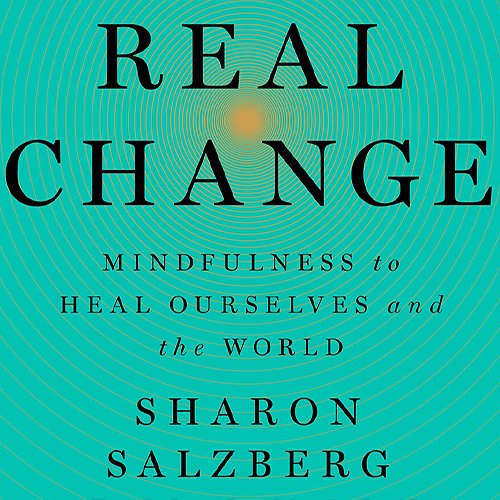
How do we navigate the overall unruliness of life, so filled as it is with urgencies—tasks left undone, friends who need help, health problems, financial pressures, family crises, community crises, world crises?
How do we sustain ourselves, our sanity, our open hearts and clear vision in the face of these ongoing challenges? In Buddhist psychology, the answer is equanimity.
The Be Here Now Network presents wisdom for how we can bring balance into every corner of our lives from Sharon Salzberg’s new book, Real Change:
When I think of equanimity, I turn to the Pali word upekkha, which is most effectively translated as balance, often the balance born from wisdom. For some, the word equanimity implies coolness, indifference, or even fear masquerading as being “just fine.” A teenager shrugging and saying, “Whatever,” is a perfect example of that particular impression of equanimity. It feels mean, doesn’t it, as you’re trying to offer care or help, to be met with a “Whatever”?
Another idea that people presume for the meaning of equanimity is passivity. In that view, if you approach bad things with equanimity, maybe you’re just a doormat being walked on or a dry
leaf asking to be blown about by the winds of change.
The word balance itself can also be misunderstood. Sometimes it’s dismissed as a forced or constrained state achieved through valiantly propping something up (like cheerfulness) while simultaneously pushing something else down (like sorrow). Or holding both pleasure and pain in a tight fist, hoping the pain doesn’t leap out of your hand to take over. Balance is readily seen as mediocrity, something bland, a series of concessions that takes you to the lowest common denominator.
A few years ago, I was in a marketing meeting related to a program I was involved in at the Garrison Institute. For four years, we had offered yoga and meditation as resilience skills for frontline workers in domestic violence shelters. At that point, the program was exploring expanding that skills training to international humanitarian aid workers, which required rewriting all of the material, so we gathered to talk about how to do that. I tried to explain the changes I had seen the frontline workers go through during the program, and I found myself apologizing: “I know it’s not an exciting word or a compelling word—it can
I tried to explain the changes I had seen the frontline workers go through during the program, and I found myself apologizing: “I know it’s not an exciting word or a compelling word—it can easily sound kind of boring—but an enormous benefit described by them was an increase in balance.”
At that point, every one of the marketing team members laughed. “You know who really likes the word balance?” one of them asked. “Anyone who feels out of balance. That’s a lot of
people!”
Join Sharon Salzberg and her guests as they explore the different ways that we can bring “Real Change” into our lives on the Real Change Podcast Series
Feeling Intensity without Being Overwhelmed
The kind of balance I’m talking about is not a measurement of how much time you spend doing one thing and then another, trying to create equality between them. Instead, it has to do with having perspective on life, and the effort you’re putting out, and the changes you’re going through. We establish this sense of balance within. It demands of us wisdom, and it gives us a growing sense of peace.
Balance doesn’t come from wiping out all feeling. We don’t have many models for navigating strong emotions in a more balanced way. It’s an uncommon trait. Many of us are conditioned toward extremes. When it comes to feeling painful emotions like anger, we may get lost in them, such that they become toxic and seemingly inescapable. We may think there’s no way out, and we come to identify with our feelings completely: I’m an angry person, and I always will be.
On the other hand, we may tend to feel an impulse to turn away from tough feelings—to swallow them, deny them, distract ourselves. Whether we’re drowning in these painful emotions or
pushing them away, it’s still putting pain on top of pain.
Equanimity is what frees us from these dynamics; we can learn to be present with emotions without falling into the extremes of overwhelm or denial. Equanimity is the state in which we can recognize an emotion like anger—and even feel its full intensity— but also pay attention to choosing how we will respond to a given feeling, thought, or circumstance.
One of my favorite illustrations of this phenomenon comes from Andrés Gonzaléz of the Holistic Life Foundation, whom we first met in chapter 3. He told me the story of eight-year-old Janaisa, one of the girls in the after-school program they run, who had a history of getting into fights with her peers. “Boys or girls, it didn’t matter, they would make fun of her and she’d knock them out,” he says. But then one day in the gym, when another girl made a disparaging remark about her, Janaisa grabbed her and slammed her against the wall. “She then silently looked at the girl,” recalled Andrés, “and then dropped her, saying, ‘You’d better be glad I meditate.’”
We can choose not to make an enemy of our feelings, as intense as they may be. Instead, we can expand our awareness and allow those feelings to come up. And we can allow them to move and shift. That space brings the wisdom that keeps us from getting lost in immediate reactivity. That freedom is the essence of equanimity.
– Sharon Salzberg
Want to continue reading? Click below to get your copy of Real Change:
Excerpted from Real Change, copyright © 2020 by Sharon Salzberg, with permission from Flatiron Books.

